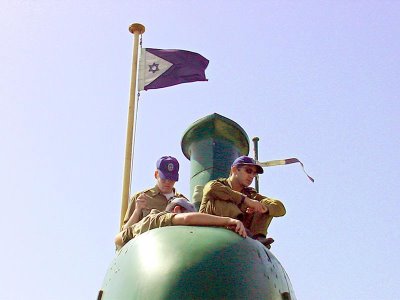Germany Sells, Delivers Two More Dolphin Subs to Israel

In November 2005, reports surfaced that that Germany would sell Israel 2 AIP-equipped SSK Dolphin Class submarines. In 2006, the deal was finalized at a total of $1.27 billion, with the German government picking up 1/3 of the cost. The new boats were built at the Howaldtswerke-Deutche Werft AG (HDW) shipyard, in the Baltic Sea coastal city of Kiel.
Now, reports indicate that both submarines have been delivered early…
The Dolphin Class, and Its Improvements
The Dolphins are quiet diesel-electric attack submarines that evolved from Germany’s famous and ubiquitous U209 Class. They can fire torpedoes and missiles from their 533mm torpedo tubes, perform underwater surveillance, and even launch combat swimmers via a wet and dry compartment.
Germany had already donated two Dolphin submarines to the Israeli navy after the Gulf War in the early 1990s. The first-of-class INS (Israeli Naval Ship) Dolphin was commissioned in 1999, while INS Leviathan was commissioned in 2000. The Israelis later bought a 3rd submarine for $350 million total, using a 50/50 shared cost arrangement with the German government. INS Tekuma (“revival, renewal”) also entered service in 2000.
The Dolphin subs are reportedly designed for a crew of 35 and can support 10 passengers. They have a maximum speed of 20 knots (though as diesel subs, their endurance at speed is limited), and a maximum range of 4,500 km/ 2,700 miles. The submarines incorporate Atlas Elektronik’s ISUS 90-1 TCS for provides automatic sensor management, fire and weapon control, navigation and operation.
Dolphin submarines are versatile and heavily-armed, with a wet and dry compartment for deploying underwater swimmers, and no less than 10 bow torpedo tubes. Four of the tubes have a 650mm diameter, which can launch larger cruise missiles, but are also useful for launching commandos in swimmer delivery vehicles (SDVs). The other 6×533mm tubes can launch STN Atlas Elektronik’s DM2A3 torpedoes or anti-ship missiles (likely Boeing’s UGM-86 Harpoons). Underwater mines offer another option.
It is also rumored that Israel has tested a nuclear-capable version of its medium-range “Popeye Turbo” cruise missile design for deployability from the 650mm torpedo tubes in its Dolphin Class submarines. The 2002 Popeye Turbo launch test location off Sri Lanka suggested that the tests may have been performed in cooperation with India.
The rumors concerning Israel’s nuclear-capable cruise missiles had stalled additional Dolphin class sales in 2003, as had Israeli issues with the price tag. Israel’s Navy is widely considered to be last among the country’s services on the spending priority list, and so finds itself with less latitude than the Army and Air Force. The final $846 million/ $424 million Israeli-German deal for 2 more submarines addressed Israeli price concerns to some extent, provided a job creation benefit for the German government, and completed the 2nd major long-delayed arms sale that the Schroeder government solidified during its final month in office.[1]
The AIP system chosen for the 2 newest Dolphin boats was not specified. While HDW owns Kockums AB and its successful Stirling AIP system, it also has its own technology using Siemens PEM hydrogen fuel cells. This HDW system is used in the U212/214 Class, which the Dolphins resemble and which are also derived from the U209 1300/1400 subs.
Contracts and Key Events
Sept 29/09: Reports surface that Israel has taken delivery, thanks to quotes from an anonymous Israeli military spokesman that “We have received two Dolphin-class submarines built in Germany.” Delivery was initially expected in 2010. Agence France Presse | Ennahar in Algeria | The News International in Pakistan.
Aug 22/06: The Jerusalem Post reports a formal contract signing for 2 SSK Dolphin Class diesel-electric submarines. EADS is also a player in the deal following its acquisition of Atlas Elektronik. Unlike their 3 predecessors, these submarines would incorporate an AIP system in order to allow them to spend far more time submerged; most likely HDW’s system used on the U-212 Class.
The Jerusalem Post reports that the contract was signed after a long dispute over the price and financing, though the final cost in dollars ($1.27 billion) is slightly higher than the 2005 reports of EUR 1 billion/ $1.17 billion. A third of the deal (about $425 million) will still be financed by the German government, however, effectively offering a foreign aid subsidy to jobs and production at HDW.
The same article also noted that the Israeli Navy is also considering a Fixed Underwater Sonar System off its coast, in order to improve detection of foreign submarines.
Nov 2005: Defense-Aerospace relays reports from Der Spiegel and Focus that Germany will sell Israel 2 AIP-equipped SSK Dolphin Class submarines for EUr 1 billion, then about $1.17 billion.
FOOTNOTES
1 Before the Israeli submarine contract was issued, the outgoing German government broke a logjam and agreed to sell 298 surplus Leopard 2 battle tanks to Turkey.

